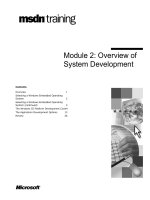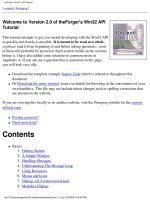2 physics of sound
Bạn đang xem bản rút gọn của tài liệu. Xem và tải ngay bản đầy đủ của tài liệu tại đây (509.55 KB, 45 trang )
Physics of Sound
Part 1
Sound waves
How they are generated and
travel
Sound Waves
Generation and Propagation
Sound wave = changes in pressure caused by
vibrating object
Sound needs a medium to “vibrate”
Compression = High pressure
Rarefaction = Low pressure
Usually air, but could be anything
Speed of sound depends upon the medium
Air = 1130 ft/sec
Water = 5000 ft/sec Steel = 13000 ft/sec
Measuring sound waves
Sound waves are longitudinal waves
Vibrating object compresses the air around it.
Pushes air away leaving an area of low pressure
Vibrating object then compresses more air to create a
“chain”
Measuring methods
Cycle
A single push and pull of the vibrating object
One are of compression followed by one area of
rarefaction
An initial increase in atmospheric pressure from the
norm, followed by a drop below the norm and then a
return to normal
Mathematically displayed by a sine curve
Pressure on Y axis
Time on X axis
Measuring methods
Period (T) and Frequency (f)
Period - The time it takes to create one cycle
Frequency - The number of cycles in one second
1
f =
T
Measured in Hertz (Hz) or cycles per second
Measuring methods
Example
It takes ¼ sec to create one cycle. What is
the sound wave’s frequency?
1
f =
= 4 cycles per second
.25
Measuring methods
Frequency will determine pitch
High frequency = high pitch
Low frequency = low pitch
Octave – a doubling of halving of the
frequency
Measuring methods
Human hearing range
Low range between 15 to 30 Hz
With enough power lower than 15 Hz can be felt, but
not heard as “sound”
High range varies with age and gender
Women - up to 20 kHz
Men – between 15 to 18 kHz
High frequency range will lower with exposure to high
levels of sound and age
Tuning
Traditional orchestra would tune First Chair Violin A first.
Remaining instruments would tune relative to that
A above middle C was tuned to about 420 Hz
As halls grew larger it was found to be desirable to tune sharper
1939 A was established to be 440 Hz
Corresponds to the 49th key on a full size piano
Tuning is not a science. The relative frequency difference is
what is important
Measuring methods
Wavelength
The distance from one area of compression
to the next or one area of rarefaction to the
next
v
λ=
f
l=wave length
V = velocity of sound in medium
usually 1130 ft/sec
f = frequency
Measuring methods
Amplitude
How high the pressure goes above and below
normal atmospheric pressure
Corresponds to how loud the sound is
“loudness” is relative to frequency and dependant
on the listener.
Timber and Harmonics
Harmonics – multiples of a base frequency
Timber – the characteristics of a particular sound or
instrument
Different harmonics combined in different levels
Physics of Sound
Part 2
Basic Acoustics
Inverse square law
Reinforcement/cancellation
Interference
Phase
measurement of where the amplitude of a wave is
relative to another wave
A cycle can start at any point in a waveform
Two waves with the same frequency can start at
different times
Measured as an angle in degrees
Related to the sine wave representation of the wave
Interference
Constructive of
destructive interference
Waveforms will add by
summing their signed
amplitude at each instant
in time
Beats
Happens when two
slightly different
frequencies interfere
Often used in tuning
Standing waves
When sound waves bounce off
of obstructions, they can
interfere with themselves
Tends to reinforce some
frequencies and attenuate
others
Prevented by using
Non- Parallel walls, ceilings
Convex surfaces
Multi-level ceiling sections
Reverberance (Reverb)
Consisting of multiple, blended sound images caused by
reflections from walls, ceilings and other structures which do not
absorb sound
NOT echo
Echo consists of individual, non-blended sound images
Reverb time is related to
The time it takes for a sound to reduce to an inaudible level
Loudness of sound relative to background noise
Ratio of loudness of reverberant to direct sound
Short reverb time (less than 1.5 sec) is better for speech or
drama
Long reverb time (more than 1.5 sec.) is better for music
Absorption
Controlling reflections can reduce or increase reverb
time
Air tends to absorb frequencies above 2K Hz
Sight line obstructions
Frequencies above 10 kHz tend to not bend around
corners well or other obstructions
l=1.3 inches for 10 kHz tone
Frequencies below 1kHz do very well
l=5.65 feet for 200 Hz tone
Specialists are often hired to “tune” a space
acoustically
Acoustic attributes
Defined by Leo Beranek after a 6 year study
of 54 concert halls
Used to define acoustic properties in terms
that other trained professionals can
understand
Acoustic attributes
Intimacy – Indicates the size of a room
How it sounds to the listener, not actual size
Determined by the initial-time-delay-gap (ITDG)
Interval between the sound that arrives directly at the
ear and the first reflection
Usually considered to be the most important
attribute
Acoustic attributes
Liveness
Related to Reverberance
Room size is related
More reflections is live. Less reflections is dry or
dead
Warmth
More low frequency sound relative to mid
frequency
Too much low frequency sound is said to be
“Boomy”
Acoustic attributes
Loudness of direct sound
Inverse square law
Loudness of sound will decrease by one quarter
every time the distance from the source is
doubled
Definition or Clarity
Good definition when sound is clear.
Related to intimacy, liveness, loudness of direct
and reverberant sound
Acoustic attributes
Brilliance
A hall that has liveness, clarity and intimacy
Diffusion
Relates to the orientation of reverberant sound
Where is the reflected sound coming from
It is preferable to have reverb sound coming from
all directions
Intensity
Like pitch, loudness is a sensation in the
consciousness of a listener
To produce a sound twice as loud requires
10 times the power
Inverse square law
Sound level is reduced by a factor of the square
of the distance away from the source
If you move double the distance from the source, the
sound intensity will by one quarter









